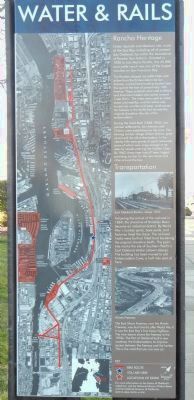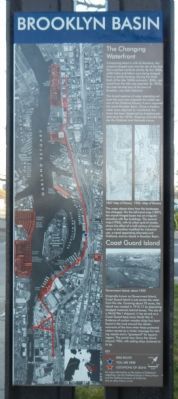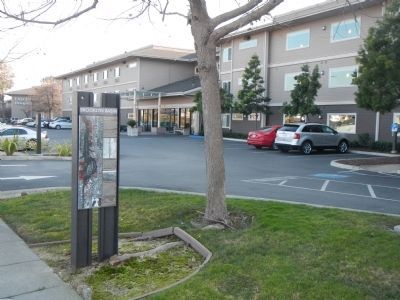East Peralta in Oakland in Alameda County, California — The American West (Pacific Coastal)
Water & Rails / Brooklyn Basin
Inscription.
There are two plaques, mounted back-to-back, on the same support for this marker.
Under Spanish and Mexican rule, much of the East Bay, including all of present-day Oakland, lay within the boundaries of Rancho San Antonio. Granted in 1820 to Luis Maria Peralta, this 45,000 acre cattle ranch was one of the largest ranchos on San Francisco Bay.
The Peraltas shipped out cattle hides and tallow from the Embarcadero de San Antonio, a small boat landing located near this spot at the foot of present day 14th Avenue. These products were sold to British and American traders who sailed around Cape Horn. The hides wee used to make shoes and saddles, and the tallow was turned into candles and soap. Look across the freeway to the bluffs that form the original shoreline – sight of the embarcadero.
During the Gold Rush (1848 – 1854), two pioneer settlements, San Antonio and Clinton, were established on the cove. The thriving lumber village of San Antonio grew up around the old embarcadero. In the nearby hills were groves of giant redwoods, some of which were large enough to be seen by vessels entering the Golden Gate. By 1860, these trees had all been logged, providing lumber for the new towns and cities around the bay.
Transportation
Following the arrival of the railroad in 1869, the shoreline of Brooklyn Basin became an industrial district. By World War I, lumber yards, boat yards, and factories lined the shore. The railroad tracks were built on filled land bordering the original shoreline bluffs. The palm tree marks the site of Southern Pacific’s East Oakland station (shown above). The building has been moved to old Embarcadero cove, a half mile east of here.
The East Shore Freeway, now the Nimitz Freeway, was built shortly after World War II. It was the East Bay’s first major highway. The view above shows the freeway in the 1950s. The Port of Oakland built a new roadway, the Embarcadero, to improve access between the freeway and the harbor. This is the road you are now on.
The Changing Waterfront
Comprising about a mile of shoreline, this crescent-shaped cove was the site of the East Bay’s earliest maritime activity. By the 1830s, cattle hides and tallow were being shipped from a nearby landing. During the Gold Rush of the late 1840s and early 1850s, redwood from the hills was exported. By 1870s, the area formed part of the town of Brooklyn, now East Oakland.
The broad expanse of water extending out from the cove was originally the widest section of the Oakland Estuary. It soon acquired the name Brooklyn Basin. Once a shallow-water area
adjoined by marshland, the basin has been deepened by dredging projects since the 1870s. Shipping channels border the Oakland and Alameda shores.
The maps above show how the landscape has changed. On the left-hand map (1857), the marsh-fringed basin has an irregular shoreline with few buildings. The second map (1929), with its urban grid of streets, shows the effect of a half-century of harbor work – a shoreline modified by industrial use, a canal separating Alameda and Oakland, and an island in Brooklyn Basin.
Coast Guard Island
Originally known as Government Island, Coast Guard Island is just across the water from this site. Covering about 70 acres, the island was created in 1915-17 by depositing dredged materials behind levees. The site of a World War I shipyard, it has served as a Coast Guard base since World War II. Evidence of sunken wooden ships has been found in the mud around the island – remnants of the time when these protected waters served as a winter moorage for sailing vessels and a “graveyard” for square-riggers. The areal view shows the island around 1920, with sailings ships clustered at its tip.
Topics. This historical marker is listed in these topic lists: Settlements & Settlers • Waterways & Vessels. A significant historical year for this entry is 1820.
Location. 37° 47.186′ N, 122° 14.812′ W. Marker is in Oakland, California, in Alameda County. It is in East Peralta. Marker is on Embarcadero, on the right when traveling south. Touch for map. Marker is at or near this postal address: 1717 Embarcadero, Oakland CA 94606, United States of America. Touch for directions.
Other nearby markers. At least 8 other markers are within walking distance of this marker. 1920 Moving the World's Cargo (approx. half a mile away); 1930 Where the World Comes to Oakland (approx. half a mile away); Cryer & Sons (approx. 0.6 miles away); California Cotton Mill (approx. 0.6 miles away); Union Point (approx. 0.7 miles away); Sígame/Follow Me (approx. ¾ mile away); The History of the Site of the Shade Tree (approx. 0.8 miles away); Francis Marion “Borax” Smith (approx. one mile away). Touch for a list and map of all markers in Oakland.
Credits. This page was last revised on February 7, 2023. It was originally submitted on January 21, 2014, by Barry Swackhamer of Brentwood, California. This page has been viewed 753 times since then and 34 times this year. Photos: 1, 2, 3. submitted on January 21, 2014, by Barry Swackhamer of Brentwood, California. • Syd Whittle was the editor who published this page.


